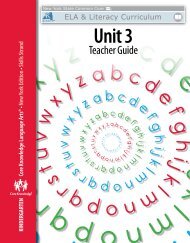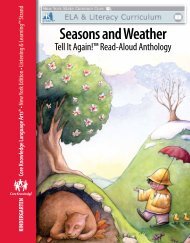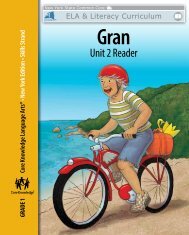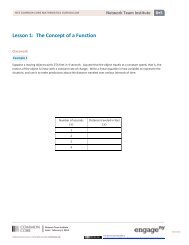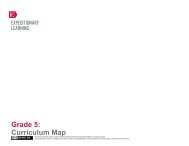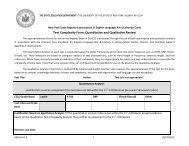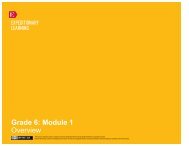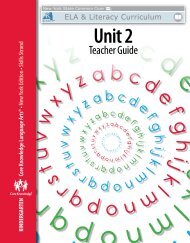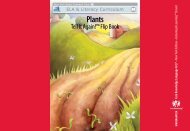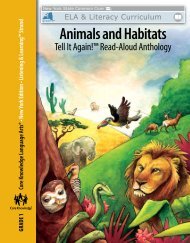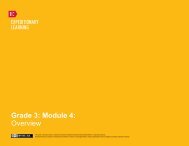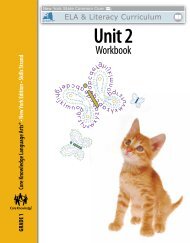Skills Unit 2 Teacher Guide - EngageNY
Skills Unit 2 Teacher Guide - EngageNY
Skills Unit 2 Teacher Guide - EngageNY
Create successful ePaper yourself
Turn your PDF publications into a flip-book with our unique Google optimized e-Paper software.
• Work with students to first write the beginning, then the middle, and finally<br />
the end of the story, asking students to help you transform the notes on the<br />
planning sheet into complete sentences. Be sure to use temporal words to<br />
describe the sequence of events (first, next, then, last, etc.).<br />
• Assist them in formulating sentences that convey dialogue, e.g., Jane said,<br />
“Who will buy my milk?” and point out the appropriate use of punctuation,<br />
especially noting the quotation marks.<br />
• As you transcribe the oral sentences, continue to model and emphasize<br />
written sentences beginning with a capital letter and ending with a<br />
punctuation mark.<br />
• Although we encourage you to keep the story short, try to write more than<br />
one paragraph. Explain that when writers write more than a few sentences,<br />
they divide their writing into sections called paragraphs. Explain that each<br />
paragraph is indented. Model for students how to indent by placing your<br />
pointer (index) finger down and beginning to write the first sentence of the<br />
paragraph after your pointer finger. Model this in the draft.<br />
• Tell students the ending sentence of the story should wrap up the story<br />
and let the reader know the story is finished. This is a good place to remind<br />
students this particular story is a fable. A good way to end this retelling of the<br />
story is to include a moral: “Take one step at a time.”<br />
• Write the ending sentence on the chart paper. You may also wish to add “The<br />
End” at the end of the paragraph. “The End” should not replace the actual<br />
ending sentence.<br />
• Read the draft to the class or read it aloud together.<br />
• Remind students drafting is the second step in the writing process. In their<br />
draft they wrote a starting sentence that introduced characters and setting,<br />
the next sentences outlined the plot, and an ending sentence wrapped up the<br />
story. The draft is written in paragraph format.<br />
• Tell students in the next lesson they will edit their story.<br />
Supplemental Materials<br />
• Decodable words:<br />
1. brown<br />
2. down<br />
3. how<br />
4. now<br />
5. town<br />
6. power<br />
7. flowers<br />
8. allowed<br />
9. crowd<br />
10. cow<br />
11. tower<br />
12. powder<br />
13. crown<br />
14. owl<br />
15. shower<br />
16. vowel<br />
17. towel<br />
74 <strong>Unit</strong> 2 | Lesson 7<br />
© 2013 Core Knowledge Foundation



